Xiaomi Mi A2 Review
Xiaomi Mi A2
An affordable phone that punches well above its weight
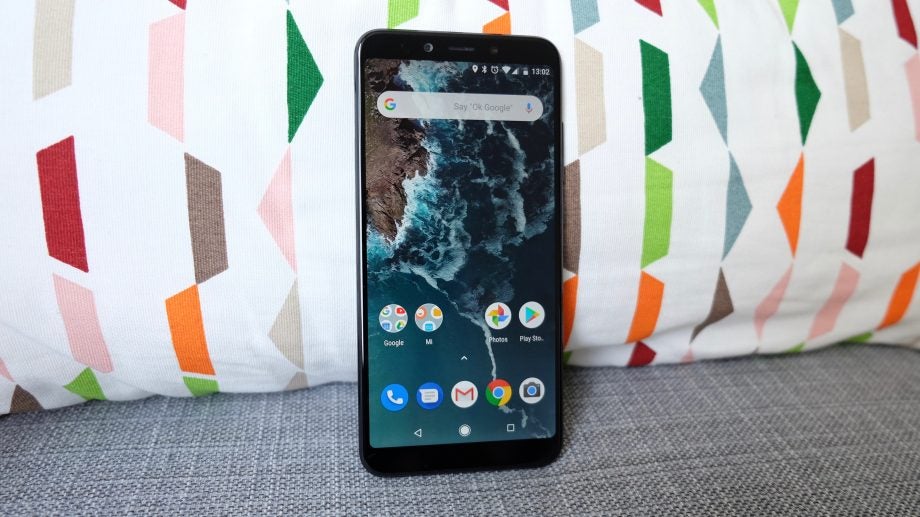
Verdict
Pros
- Strong performance for the price
- Classy build quality
- Pure Android
Cons
- Screen brightness low and adaptive setting way off
- No NFC or headphone jack
- Limited availability
Key Specifications
- 5.99-inch 2160 x 1080 18:9 IPS LCD screen
- Snapdragon 660 octa-core 2.2GHz
- 4GB RAM
- 64GB of storage
- 12MP + 20MP dual rear cameras
- 20MP front camera
- 3000mAh battery
- Fingerprint sensor
What is the Xiaomi Mi A2?
Android One was initially conceived as a way to provide a clean, fast, Google-approved UI for the kind of super-affordable smartphones sold in developing countries.
Last year’s Xiaomi Mi A1 allied this blank canvas of an operating system with mid-range hardware at a highly affordable price. It turned out to be a potent combination.
This year’s Xiaomi Mi A2 represents the Chinese company’s second bite at the Android One cherry. While the improvements are slight and the phone is in many ways rather generic, it still somehow feels like a bracingly fresh package.
At the time of writing there’s no word on UK availability or pricing, but at €249 we know it’s going to be temptingly affordable – if, or when, it finally shows up here. The Moto G6 Plus might just have met its match.
Xiaomi Mi A2 – Design
The Xiaomi Mi A2 design is pure Xiaomi. Which is rather polite way of saying it’s deeply reminiscent of Apple’s recent iPhone work, with the odd crowdsourced Android element for good measure.
This is essentially the exact same phone as the Mi 6X, at least in terms of hardware. From the front, it’s something of a blank slate, with only the slightly rounded corners of its 18:9 display and a tastefully muted notification light offering any hint of flamboyance.
The bezel around the display isn’t as slender as some of the phones you’ll see further up the pricing ladder, but they’re certainly not chunky either.
From the back, the shape and positioning of the Mi A2’s dual-camera unit is pure iPhone X. It protrudes even more than on Apple’s flagship phone, however, which causes the Mi A2 to wobble and clatter quite alarmingly when you lay it down on a hard surface.
Related: Best cheap and budget phones
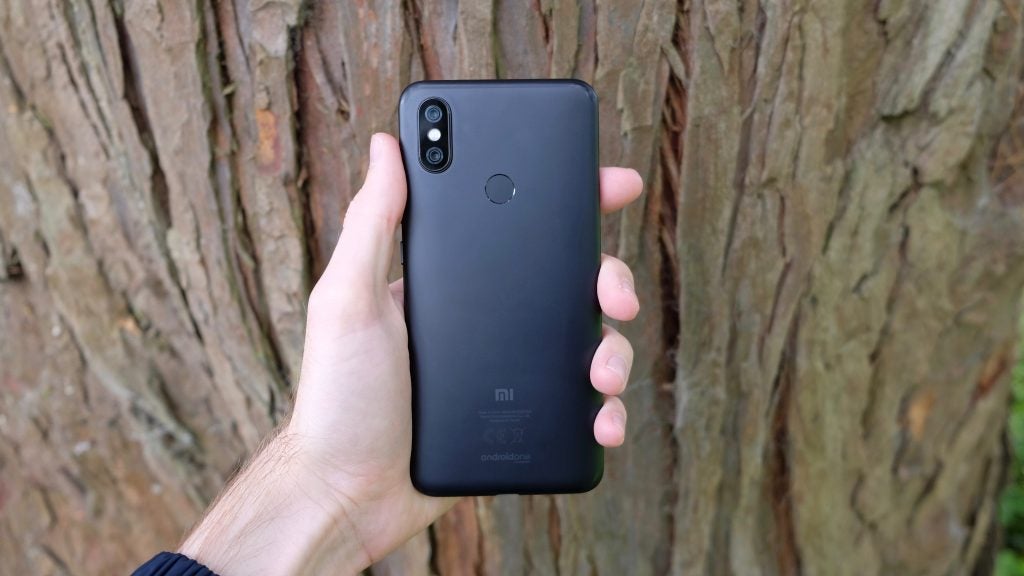
The positioning of the phone’s fingerprint sensor three quarters of the way up the back of the phone is redolent of any number of Android rivals. Which is fine, because it’s easy to feel out, fast and reliable.
Xiaomi clearly didn’t get the 2018 memo that glass is in; the Mi A2’s body is formed of a single piece of matte aluminium. It might not be the hippest cat on the block, but at least this phone will survive a trip to the floor with only a minor ding to show for it.
At this price point, such things arguably count even more than for those who can afford to splash out £1000 on a smartphone.
Derivative design aside, this is a quietly impressive phone to wield, with a slim 7.3mm body and a just-so weight of 166g. It feels dense, but not heavy. The stealthy all-black colour of the review model only adds to this sensation of understated quality.
With this combination of design influences, the Mi A2 reminded me of the OnePlus 5 – another Android phone that wasn’t exactly a design innovator, but which felt great in the hand.
On the bottom of the phone you get a pair of drilled speaker holes (only one of which is actually a functioning speaker) flanking a USB-C port.
Flipping to the top of the phone, you’ll find an increasingly niche yet highly useful feature in the form of an IR blaster. Together with the bundled Mi Remote app, you’ll be able to use the Xiaomi Mi A2 as a stand-in for most of your remote controls.
Unfortunately, even more notable than this bonus inclusion is what the Xiaomi Mi A2 leaves out. After our complaints concerning the Xiaomi Mi A1 last year, there’s still no NFC here. That means you won’t be able to make use of Google Pay to make mobile payments.
To a certain extent I could understand the lack of NFC if the primary market for the Mi A2 involves countries that haven’t yet embraced mobile payments. But given that this is supposedly a global phone, it’s a little tougher to swallow.
Yes, there’s an adapter bundled in here, but it’s a half-baked solution to a self-inflicted problem.
Xiaomi Mi A2 – Display
Xiaomi has equipped its Mi A2 with a large 5.99-inch display, which stretches out in the obligatory 18:9 aspect ratio. It isn’t unmanageable, but in the unlikely event you haven’t grown accustomed to using a second hand for general operation by now, you’d better learn to do so.
As with its choice of metal rather than glass on the rear of the phone, Xiaomi has ignored prevailing trends on the front. There’s no notch to be found. This is a pure rectangle of a display, rounded corners excepted.
With a Full HD+ 2160 x 1080 resolution, the Xiaomi Mi A2 display is plenty sharp enough. It doesn’t get very bright though, even when you turn off auto-brightness and crank up the slider to full.
You’ll definitely want to flick that latter toggle to the off position as well. For some reason, Xiaomi’s adaptive brightness function is all over the place here. It frequently drops the screen brightness way too low in moderate indoor lighting conditions, while we often found it could get uncomfortably bright in darker conditions.
Related: Best smartphones
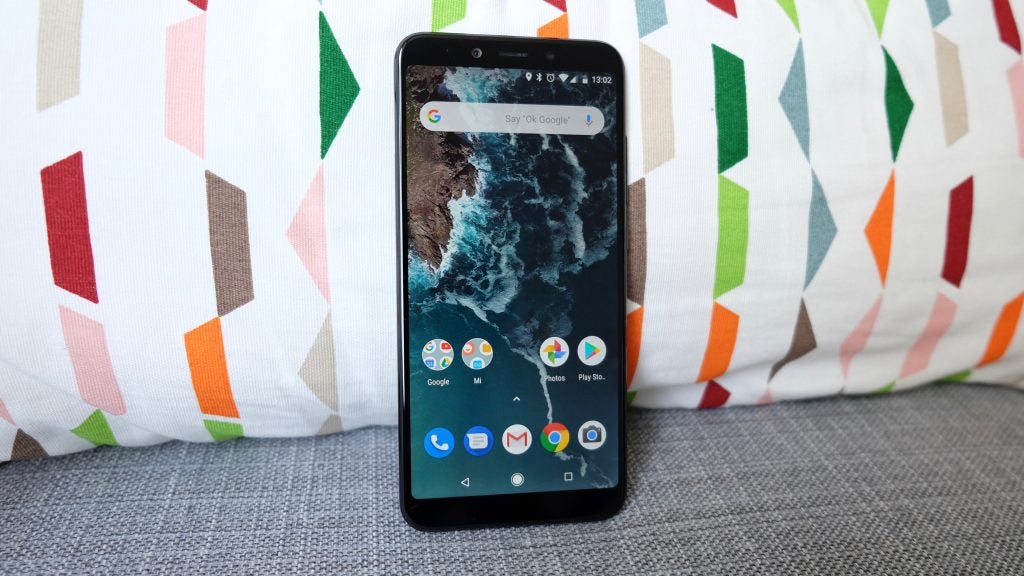
These issues aside, the Mi A2 screen is crisp and reasonably accurate. Colours don’t pop like they do on an OLED display (or even a high-end LCD), but there’s a fresh, natural tone to everything. It’s a shame there’s no facility to adjust that tone in the settings menu, though.
Xiaomi Mi A2 – Performance
The Xiaomi Mi A2 is a dazzling performer. We were reasonably impressed with its predecessor, but an upgrade to Qualcomm’s mid-range Snapdragon 660 CPU coupled with an ample 4GB of RAM (there’s also a 6GB model) means that this thing flies.
It isn’t the speediest chip on the market by any stretch of the imagination, but it comfortably passes the threshold where such things will be noticeable to most people. Homescreen navigation is flawlessly smooth, with which Android One doubtless helps. Swapping between apps is similarly hitch-free, while jumping into the camera app from sleep is nice and speedy when it works (more on that later).
Even cranking up the pressure by running advanced 3D games fails to make the Mi A2 seriously sweat. Running the current graphical showcase Asphalt 9 on High settings is a fluid (if not quite flawless) experience, with similar results for PUBG.
Only the single weedy, easy-to-cover speaker really brings the gaming experience down a notch on the Mi A2. Quite how the default alert tones manage to pierce the air (and our ear drums) so shrilly isn’t overly pleasing.
This accomplished level of performance is spelled out in cold hard figures when you jump into the Geekbench 4 benchmarking tool. An average multi-core score of 4893 places the Mi A2 comfortably ahead of the Moto G6 Plus with its Snapdragon 630, which only managed 4081.
Perhaps more indicative of the Mi A2’s competence in day-to-day running is the single-core results, which are around double that of the 866 scored by the Moto G6 Plus. This is a seriously smooth operator.
Xiaomi Mi A2 – Software
The Xiaomi Mi A2 is essentially the Mi 6X with one notable difference. It runs pure Android 8.1 Oreo, with no cumbersome MIUI interface layered on top.
It’s what many fans of Google’s OS would like to see more of – the advantage of distinctive hardware produced by the world’s top manufacturers, combined with the power of Google’s unfiltered and unrivalled software prowess.
Having lived with the Xiaomi Mi A2 for a week or so, I would happily sign up to that vision. Combining capable hardware with Google’s latest OS results in a delightful and thoroughly modern smartphone experience.
This is essentially what Google’s own Pixel family does, of course, but with bleeding-edge hardware and a price tag to match. Indeed, with no flabby custom UI on top, the Xiaomi Mi A2 somehow feels a good deal more expensive than it is.
With Android One phones, you get regular software updates as and when Google has them ready, which makes for one of the most secure Android experiences on the market. You’re far more likely to get the next major version of Android in a timely manner, too.
Related: Android 9 Pie
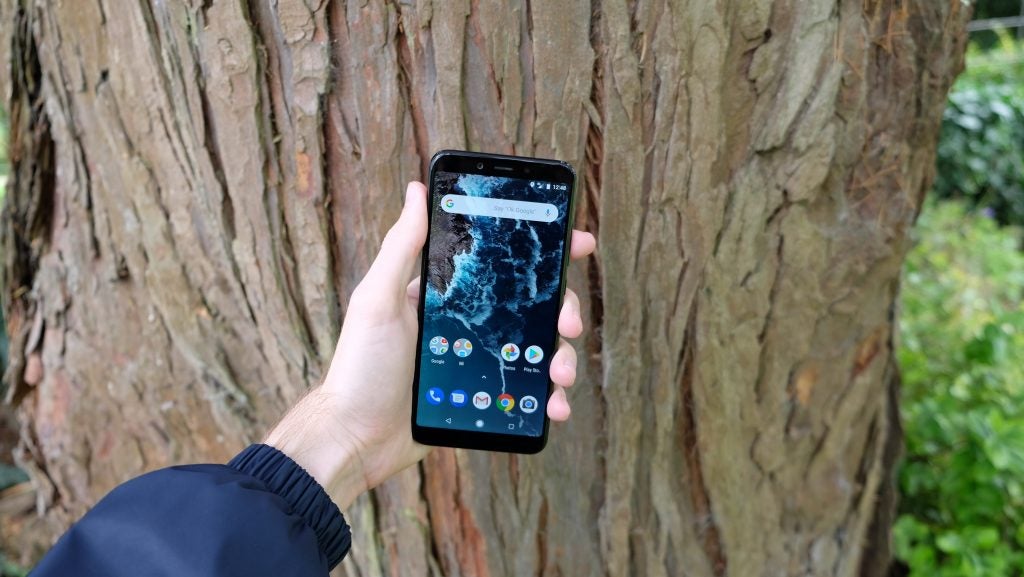
To its credit, Xiaomi has resisted the temptation to overburden the Mi A2 with custom apps. For the most part, if you want to carry out a task, there’s a Google app to help you do it, with no duplication.
Gmail and Messages are prominently featured for your basic communication needs, while Photos is right there on the homescreen to handle your snaps. Maps, Calendar, Drive, Play Music and more all share a Google folder, while even Google Keep (Google’s useful but often absent note-taking app) is pre-installed.
Xiaomi has only pre-installed a few of its own apps, and only the File Manager app duplicates the stock Android provision. Mi Drop handles local file transfers, and is instantly discardable, as is the bug-reporting Feedback app.
Xiaomi Mi A2 – Camera
The Xiaomi Mi A2 goes in strong with its camera provision. There are lots of dual-camera setups even at the low end by now, but it isn’t often that those phones feature combine 12-megapixel and 20-megapixel sensors with a wide f/1.8 aperture.
That’s great on paper, of course, but it doesn’t naturally translate to decent images. Thankfully, the Xiaomi Mi A2 comfortably lives up to its elevated camera specs.
While it doesn’t trouble the flagship brigade, the Xiaomi Mi A2 camera stands up to a host of pricier mid-range models. It takes images quickly, locks on to its subjects reliably, and produces images of decent quality for the most part.
Doubtless thanks to that swift CPU, Xiaomi has been able to set HDR to auto by default, which means that the camera will often counteract extreme variances in light and shade, without the need to tinker in the menus.
A few of the shots missed the mark on this front, with some murky landscape snaps on a particularly cloudy day. At other times, though, it worked successfully to pull detail out of the shadows, or to tone down the exposure on highly reflective surfaces.
In favourable lighting, shots were generally sharp and full of detail, with decent colour accuracy to boot. Fast-moving elements were captured, too, with minimal blur (note the car passing through the traffic lights in the balloon pic below).
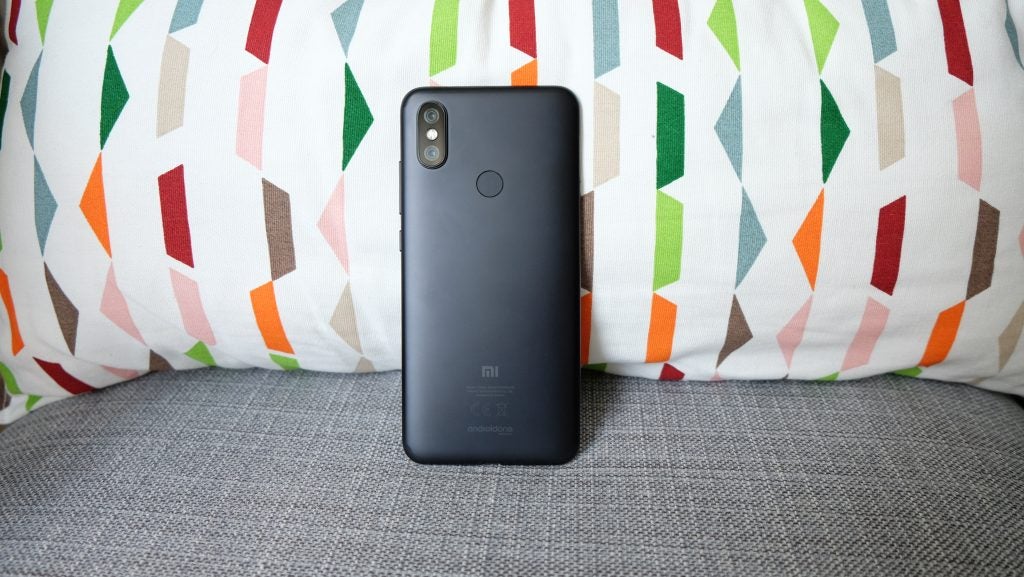
The Mi A2’s dual-camera comes into play with Portrait mode, which is a fairly common 2018 smartphone camera feature, whatever the price tag. The idea is to make the close-up subject pop by doubling down on bokeh using depth data from the second camera.
In practice, this is one of the better and more natural-looking cut-price Portrait modes around. You still get issues with blurring out the edges of the subject, but less so than with many cheap alternatives. There’s no messing around with aperture settings or post-snap editing either, which I have always found to be better in theory than execution.
At the other end of the spectrum, if you really want to fine-tune your shots, there’s a Manual mode that grants direct control over white balance, focus, shutter speed, ISO, and which of the two lenses is used.
One odd little quirk we found was a slightly buggy camera shortcut prompt. Double-tapping the power button will bring up the camera app from sleep, which works pretty snappily most of the time.
On the odd occasion, however, the phone would seem to freeze on a white screen, forcing us to double-tap again to try to force through the camera prompt. Hopefully this is something that can be patched out in future updates.
The front camera is a particularly sharp 20-megapixel unit. This takes reasonably detailed snaps, although on a few occasions the auto HDR facility didn’t seem to balance out our selfies particularly well.

HDR is on by default, and it balances out shade a light nicely

The colour and outline of the balloon are captured nicely

Challenging lighting conditions here, but the Mi A2 captures the various light sources well

A little murky in the foreground, but the clouds are suitably fluffy

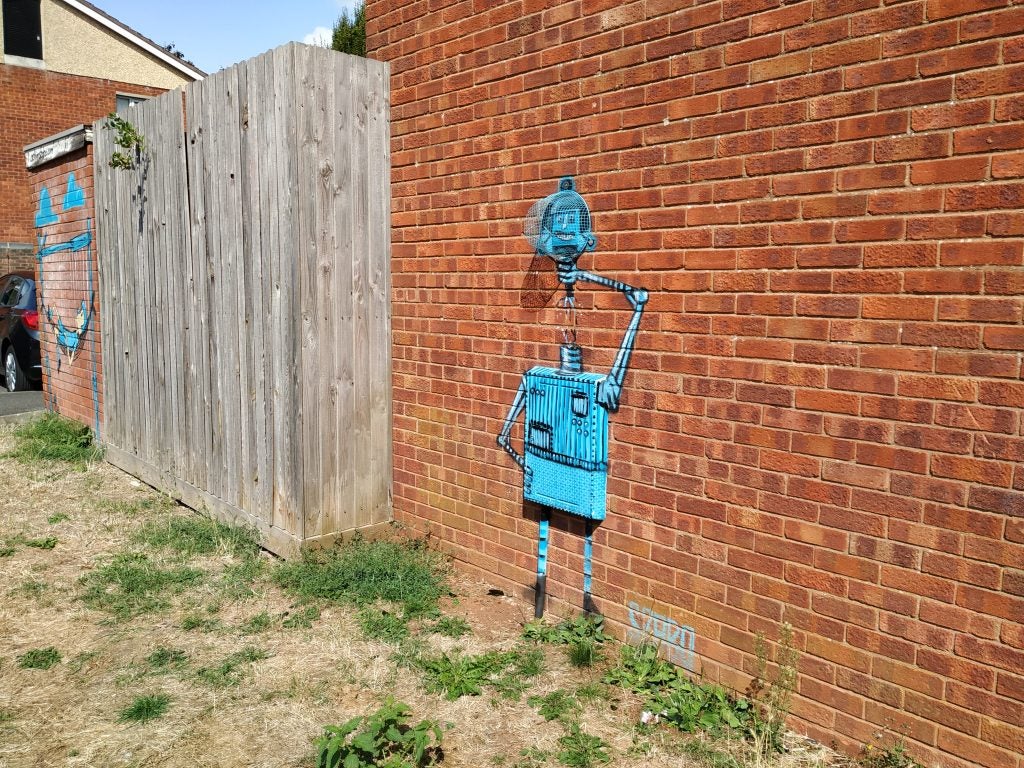
Decent detail and colour

You can get a good bokeh effect even without Portrait
Xiaomi Mi A2 – Battery Life
It would have been nice to see a slightly larger battery than the Xiaomi Mi A2’s 3000mAh unit. The Moto G6 Plus, which is a similar phone in many ways, packs a 3200mAh unit.
Perhaps with a similarly sized battery, Xiaomi could have cranked the screen brightness up a little.
That aside, the Xiaomi Mi A2 will last you through a full day of usage without too much issue. A day of slightly more than moderate usage – which included a fair amount of 3D gaming and web browsing – left me with 20% in the tank come bedtime.
On a day of extremely light usage (just an hour and a half of screen-on time), I was left with a scarcely believable 76% after a full 24 hours.
It’s a fairly obvious statement to say that using the phone more heavily will hit the battery harder, but you don’t always see such a pronounced difference between the two extremes as you do here.
Further testing reinforces this impression that the Xiaomi Mi A2 is fairly average under heavy load. After playing a 50-minute downloaded TV show with the screen brightness cranked right up, the Mi A2 lost 13% of its charge.
That positions the phone neatly between the Nuu Mobule G3 on 12% and the Honor 9 Lite on 14%.
Shooting through successive rounds of Guns of Boom for 15 minutes, with the screen brightness set to half way, the Mi A2 lost 6% of its power. That’s the same as the Honor 9 Lite and a single percentage point worse than the Nuu G3.
When it does come time to charge, the Xiaomi Mi A2 features Quick Charge technology, which the Mi A1 didn’t have. That’s a notable piece of progress.
Why buy the Xiaomi Mi A2?
If you want to get a flagship-like experience for less than £250, there isn’t a phone that gets closer right now than the Xiaomi Mi A2. Even the Moto G6 Plus can’t match it for raw pace.
Beyond performance this is a well-built, stylish (in a slightly derivative way) phone with a highly competent camera. The inclusion of stock Android 8.1 Oreo really completes that premium feel, and puts the Mi A2 beyond many of its affordable Chinese rivals.
A couple of drawbacks prevent it from being an unequivocal recommendation, however. The Mi A2’s screen doesn’t get bright enough, and the lack of both NFC and a headphone jack are tough to swallow.
Ultimately, though, the biggest downside to the Xiaomi Mi A2 is that it isn’t more widely available at the time of writing. If Xiaomi can really commit to a global launch of this range in future – and iron out those creases – it will be onto a winner.
Verdict
The Xiaomi Mi A2 is a phone that punches way above its weight. A few hardware shortfalls and limited availability drop it just short of an automatic recommendation, but this is deeply impressive stuff from Xiaomi.
How we test phones
We test every mobile phone we review thoroughly. We use industry standard tests to compare features properly and we use the phone as our main device over the review period. We’ll always tell you what we find and we never, ever, accept money to review a product.
Trusted Score
Score in detail
-
Performance 8
-
Camera 7
-
Design 8
-
Battery Life 8
-
Value 10
-
Software 9
-
Calls & Sound 8
-
Screen Quality 7


